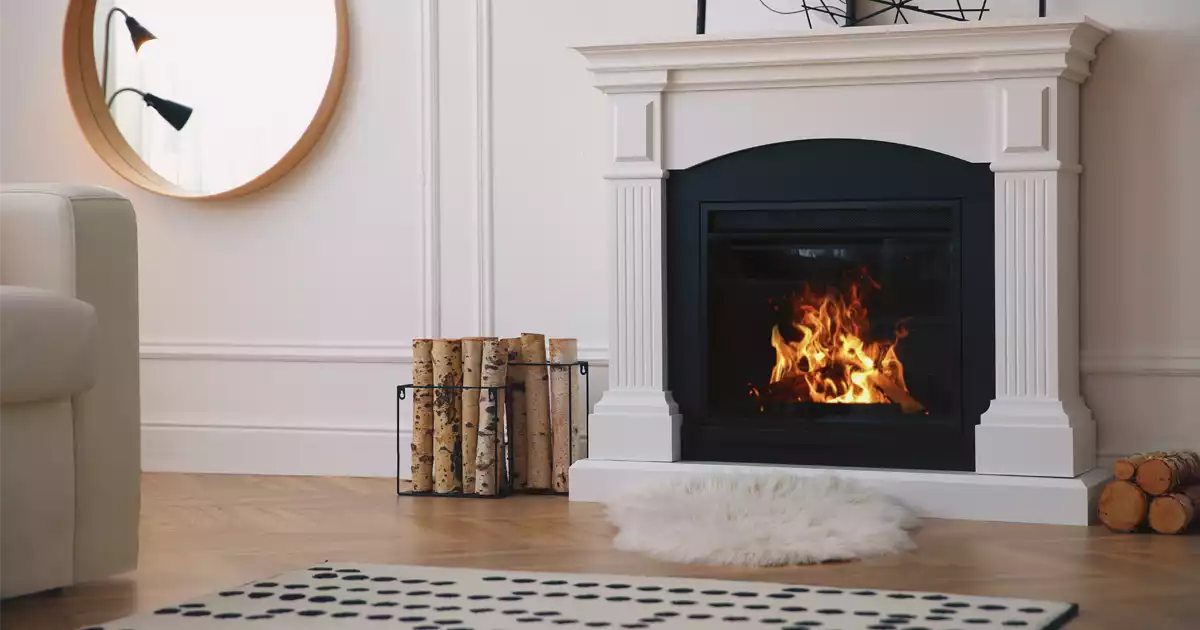Use a Whole-House Air Purifier and More Indoor Fireplace Safety Tips
3 minute read
The allure of cozying up by a crackling fireplace on a cold winter’s day is hard to resist. Unfortunately, along with that toasty warmth and relaxing glow, indoor fireplaces—as well as wood and gas stoves—release dangerous pollutants into the air that can greatly affect the Indoor Air Quality in your home. Read our indoor fireplace safety tips so you can cozy up by a fire on a cold winter day without any worries and be sure you’re taking the necessary precautions to protect your Indoor Air Quality.
Eight Indoor Fireplace Safety Tips
1. Choose the Proper Fuel
Use smaller, dry pieces of wood to ensure a hotter and cleaner burning fire with less smoke. NEVER burn wet, treated, or painted wood.
2. Prepare Your Fireplace
Open the glass doors, pull aside the screen curtains and place the kindling and wood inside. Then open the damper and a window to prevent a smoky room. (This may vary based on the construction of your fireplace.)
3. Clear Away Anything Flammable
Cool the chimney by keeping the glass doors open, but keep the screen closed to prevent sparks from jumping out. But make sure the area around the fireplace is clear of anything flammable.
4. Keep Your Kids Safe
Never leave a fire unattended when children are in the house. Install a safety screen to minimize any chances of burns if you have small children. Communicate the dangers of fires and heat as early as possible to your children.
5. Install Detectors
Install both smoke and carbon monoxide detectors, testing them monthly and changing the batteries at least once a year. Always keep a fire extinguisher on hand and be sure it is easily accessible.
6. Clean Your Indoor Fireplace Weekly
The firebox should be cleaned out at least once per week. During the cleaning, close the damper to prevent cold air in the flue from stirring up dust. Wear a dust mask and open a window to prevent negative air pressure. The firebox should be kept completely clean when the fireplace is not in use.
7. Keep An Eye on Your Coals
Coals can remain hot enough to start a fire for up to three days, so wait at least that long before removing any ashes. Levels of ash should be kept to one inch to act as insulation and allow the coals to heat faster and retain heat easier.
8. Clean Your Chimney Annually
Have a certified chimney sweep inspect and clean your chimney at least once a year. Checking your chimney for animal nests or blockages is important, even if it isn’t due for a cleaning, to ensure the smoke can escape properly. It’s essential to clean and inspect your fireplace and venting system to protect your air quality.
Bonus Tip: Use a Whole-House Air Purifier
Even properly-kept fireplaces can release harmful emissions into your home. AprilAire whole-house air purifiers can filter and remove damaging particles released from fireplaces to help your family breathe easy all winter long.
To get a whole-house air purifier installed in your home, contact a local Healthy Air Professional. Simply input your zip code, click HVAC, and find a Healthy Air Professional that installs air purifiers.
Pollutants released by your indoor fireplace:
● Carbon Monoxide (CO): A colorless and odorless gas, CO interferes with the body’s ability to utilize oxygen. Minor exposure can lead to fatigue, dizziness, weakness, headaches, confusion, and nausea which can progress to loss of consciousness and death if CO levels rise. To ensure the safety of you and your family, installing and maintaining carbon monoxide detectors and oxygen-depletion sensors is necessary.
● Nitrogen Dioxide (NO2): NO2 is one of the leading outdoor air pollutants, but can also form indoors when wood or natural gas are burned. It can cause a number of harmful effects on the lungs, including reduced lung function, worsened coughing and wheezing, increased inflammation of the airways, and increased asthma attacks.
● Particles: Particulates released during the burning of wood or gas can cause significant damage to the lungs. Difficulty breathing and/or aggravated existing conditions can result as well as particularly asthma, bronchitis, and wood smoke allergies. A number of fireplace pollutants have been linked to cancer.
Sources:
- https://www.aireserv.com/about/blog/2017/january/how-does-your-fireplace-affect-indoor-air-qualit/
- https://www.epa.gov/indoor-air-quality-iaq/wood-smoke
- https://blog.esurance.com/how-to-clean-a-fireplace-5-hacks-for-a-safe-and-warm-winter-by-the-fire/
- https://www.bobvila.com/slideshow/how-to-get-your-fireplace-ready-for-winter-48090#chimney-inspections
- https://www.chimneysaversolutions.com/blog/7-safety-tips-using-fireplace-winter/

